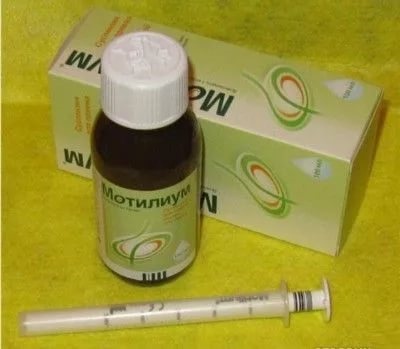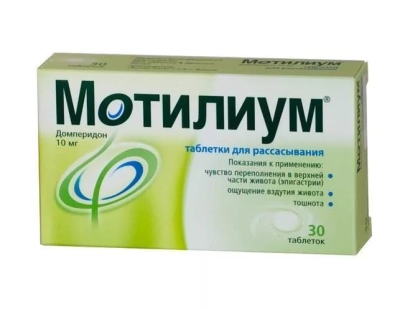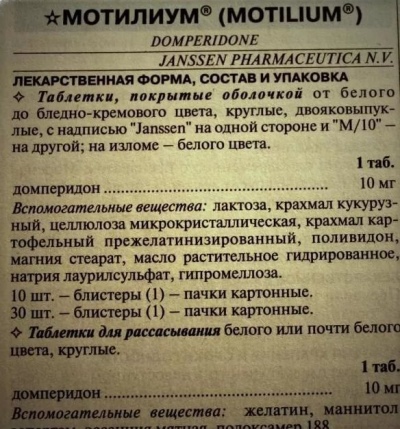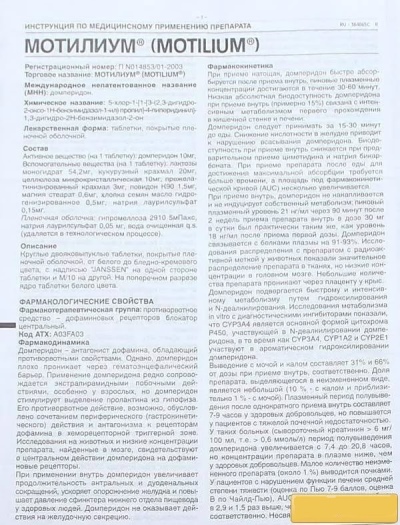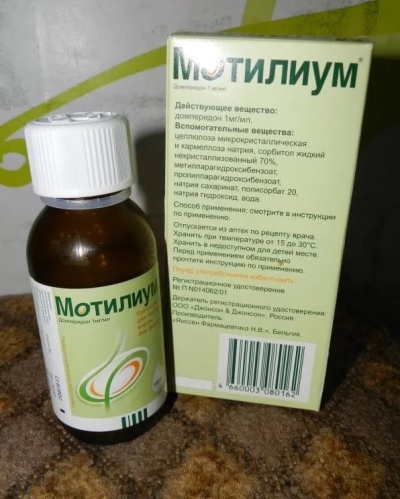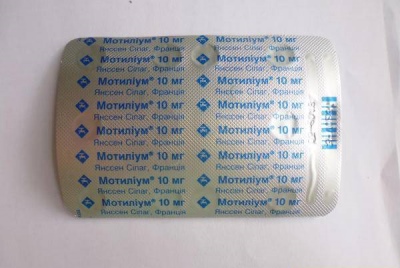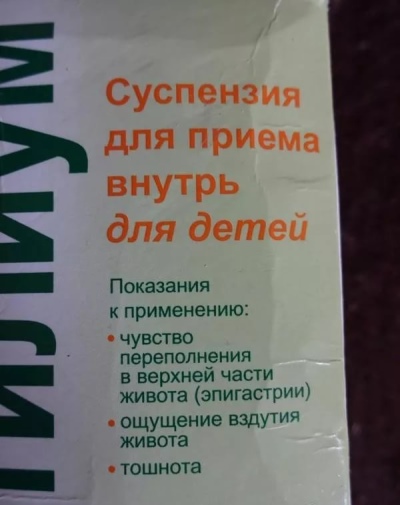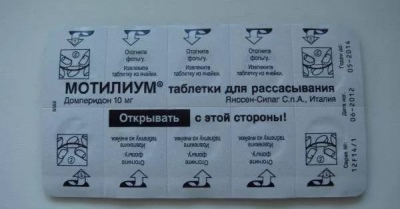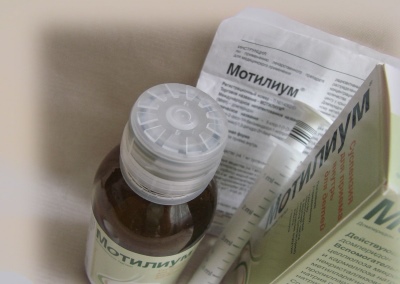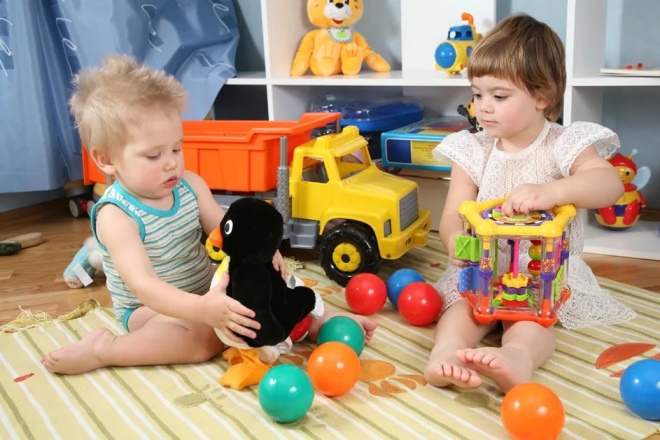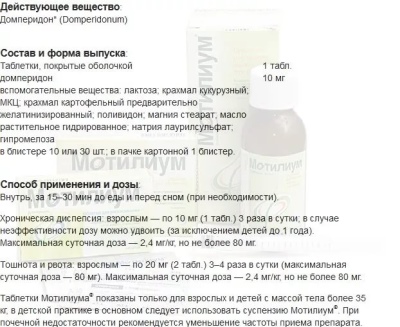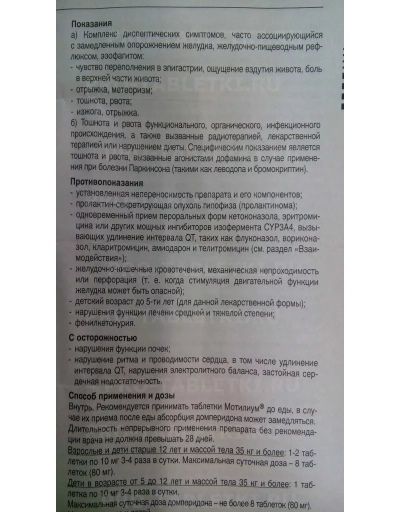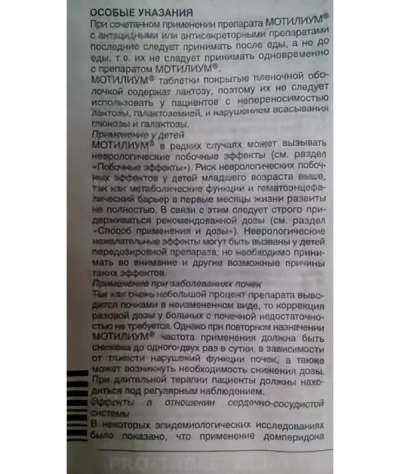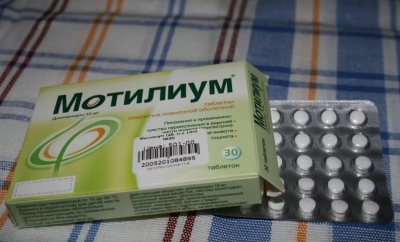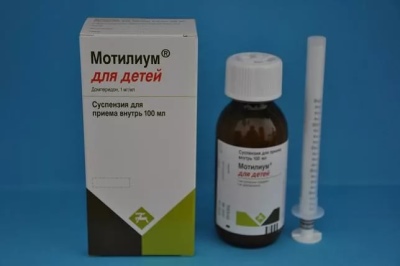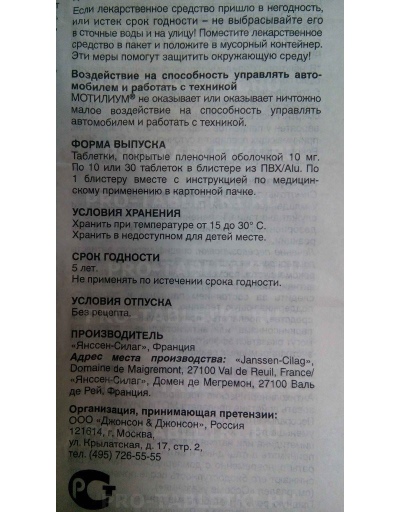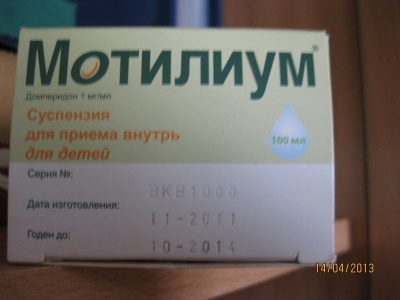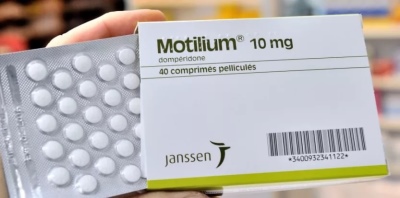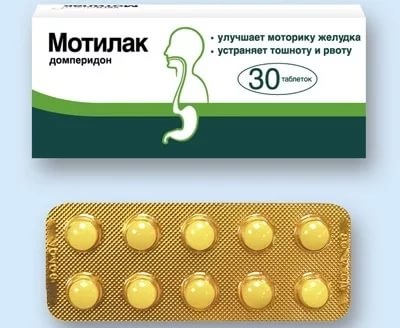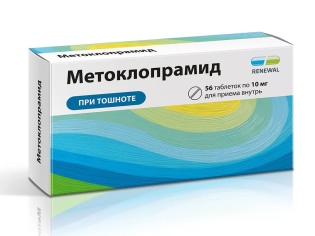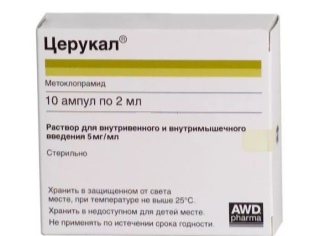Motilium for children: instructions for use
Motilium is one of the popular medicines for nausea, vomiting and other unpleasant symptoms of the stomach and intestines. It is often recommended for adults with various pathologies of the gastrointestinal tract (both chronic and acute) and with nausea caused by other factors (motion sickness, medication, etc.).
But is it possible to give this medicine to children, how does it affect the body of a small patient, in what dosage forms is it produced and in what dosage is it used in childhood?
Release form
In pharmacies Motilium is presented in three different forms:
- Suspension. It is a jelly-white homogeneous liquid with a sweet taste. This medicine is sold in glass vials, to which a dosing syringe is attached. There are two scales on the syringe for easy dispensing. One bottle contains 100 ml of syrup.
- Tablets that need to be absorbed. They have a round shape, smooth surface and white tint. One package of this medicine includes 10 or 30 tablets, packaged in blisters of ten pieces.
- Tablets in the shell. They are characterized by a round biconvex shape, cream or white color and the presence of inscriptions on each side of the tablet (on one "M / 10", on the other - in a circle on the letter "JANSSEN"). This drug is packaged in blisters of 10 or 30 tablets, and in one box contains one blister.
In candles, injections, capsules, drops and other forms Motilium is not produced.
Composition
Each of the options Motilium as a main component that provides the therapeutic effect of this drug, contains a substance called domperidone. Its amount in 1 ml of suspension is 1 mg, and the dosage in one tablet (both in normal and for resorption) is 10 mg.
Additionally, the drug, depending on the form includes:
- Sorbitol, polysorbate 20, saccharinate sodium, carmellose sodium and other substances, due to which the suspension remains liquid, homogeneous and does not deteriorate.
- Mannitol, peppermint essence, poloxamer 188, aspartame and gelatin, thanks to which lozenges are sweet to the taste and quickly dissolve in the mouth.
- Hypromellose, sodium lauryl sulfate, lactose, polyvidone, corn starch and other compounds that provide a dense core and film coat.
Operating principle
Motilium has an anti-emetic effect due to the effect of its active ingredient on both central and peripheral structures involved in the formation of the gag reflex:
- In the brain, the drug affects a certain area in the region of the fourth ventricle.called trigger chemoreceptor zone. In this area, domperidone acts on dopamine receptors, as a result of which it interferes with the conduction of impulses from the digestive tract to the emetic center in the medulla. The drug acts on the trigger zone because it is poorly protected by the blood-brain barrier.
Other parts of the brain, better protected, domperidone almost does not fall, so side effects from the central nervous system are very rare in the treatment with Mocilium (they occur more often in children because of the increased permeability of the barrier).
- Influencing the digestive tract, the drug increases the tone of the sphincterwhich separates the stomach from the esophagus, and also stimulates the motility of the stomach, with the result that food leaves the stomach more quickly, passes into the duodenal zone and moves further along the intestine. In this case, the secretion of gastric juice under the action of domperidone does not change.
The active component of Motilium after taking a suspension or tablet is absorbed quickly enough and after 30-60 minutes its concentration in the bloodstream reaches the maximum level. Metabolic changes of domperidone occur in the liver, and removal of the drug from the body partially occurs with urine (about 1/3), but to a greater extent the drug is excreted in the feces.
Indications
Motilium is used for dyspepsia caused by reflux of the stomach contents into the esophagus or by too slow emptying of the stomach.
The drug is required for:
- nausea;
- painful epigastric sensations;
- flatulence;
- regurgitation;
- heartburn;
- too fast satiety;
- feeling of fullness in the stomach;
- vomiting;
- abdominal distention;
- belching air or stomach contents.
The remedy is prescribed for vomiting or nausea, the cause of which is organic lesion of the digestive tract, functional disorders of the stomach, intestinal infection, dietary disturbances (overeating, eating unusual foods) or drug therapy.
Motilium helps eliminate vomiting and nausea in patients taking bromocriptine and levodopa, because these drugs stimulate dopamine receptors.
At what age is it allowed to take?
Motilium in liquid form is allowed from birth, since the suspension is easy to dose even for the smallest patients.
Solid forms of the drug are prescribed only from 5 years of age and provided that the child’s weight exceeds the mark of 35 kilograms. With a weight of more than 35 kg and over the age of 5 years, you can use any of the types of tablets, choosing it depending on the preferences of the child.
It is easier for one children to swallow the medication and drink it with water, so tablets in the shell are suitable for them. Others experience difficulty swallowing, so they are given medication that can be absorbed.
Contraindications
Motilium not prescribed if the child:
- There is intolerance to any of the components. A selected form of medication, for example, lactose intolerance will prevent the use of coated tablets.
- Tumor stimulating prolactin release detected (it is called prolactinoma).
- Diagnosed with gastric or intestinal bleeding, perforation of the gastrointestinal wall or intestinal obstruction (mechanical).
The drug also does not give to children with severe or moderate pathologies of the liver, and with a slight dysfunction of the function of this organ, it is necessary to use the drug with caution, but the dosage does not change. The presence of kidney disease, heart failure, an imbalance of electrolytes, or problems with conduction of impulses in the heart requires correction of the treatment regimen. Since aspartame is present in lozenges, this form is prohibited for children with phenylketonuria.
Side effects
- Taking Motilium in some children may cause allergies., and in very rare cases, causes an anaphylactic reaction.
- In infants, medication sometimes leads to nervousness. and nervous excitement, as well as motor disturbances and seizures.
- One of the actions of domperidone on the brain is to stimulate the secretion of prolactin in the pituitary glandtherefore, in the treatment with Motilium, an increase in the concentration of such a hormone in the blood and its associated side effects is possible.
- Rare side effects of the medication are called arrhythmia., urinary retention, diarrhea, headache, dry mouth, constipation, drowsiness and other symptoms.
Instructions for use
- Drink Motilium recommended before mealsas the food reduces the rate of absorption of such a drug. The optimal time of reception as a suspension, and tablets are called 15-30 minutes before feeding.
- The suspension is gently mixed before use., avoiding the formation of foam. Having collected the medication with a syringe, it is given to the child, after which the syringe is washed with warm water.
- It is advisable to remove the lozenges from the packaging very carefully, as they are very fragile.. It is best not to press on the pill, but first remove the foil from the cell and carefully get the drug. Putting the medicine on the tongue, you need to wait for its dissolution with saliva and swallow. Wash it down Motilak not required.
- Breast children and older children (up to 12 years), the dosage of the suspension is determined by weightbut you do not need to use a table for this. On the dosing syringe, which is in the package with the bottle, one scale is marked from 0 to 20 kg and the second from 0 to 5 ml. Therefore, picking up the drug, you need to focus on either the body weight of a small patient, or the right amount of milliliters. Each kilogram of children of this age requires from 0.25 mg to 0.5 mg of domperidone, which corresponds to 0.25-0.5 ml of suspension. In such a dose, the medicine is given three times a day, and sometimes it is prescribed four times the use of (additional dose at bedtime).
- Children older than five years old weighing> 35 kg, but under 12 years old instead of suspension can already be given a tablet form (as a drug for sucking, and medicine in the shell). A single dosage will be 1 tablet, and the frequency of intake can be three or four times a day.
- For children over 12 years of age, Motilium tablets are usually taken at one dose.a, but a single dose can be two tablets at the same time. At this age, you can continue to give a suspension. A single dosage of liquid medicine ranges from 10 to 20 ml. The drug is taken 3 times during the day, and if necessary, the fourth time before bedtime.
- The maximum allowable amount of domperidone per day for children weighing> 35 kg is 80 mg, that is, 80 ml of suspension or 8 tablets. For children whose weight is less, to calculate the maximum daily dosage of liquid Motilium multiply the number of kilograms by 2.4. For example, a child at the age of 2 years weighs 15 kg, which means that he can be given no more than 36 mg of domperidone per day (2.4 x 15 = 36), which is 36 ml of suspension. If we divide this dose into three doses, we get the maximum single dose of 12 ml, and if we give the drug four times a day, then no more than 9 ml per reception.
- If a child has serious kidney disease, a single dose of Motilium does not change., but the frequency of intake is reduced to twice a day, and with a strong renal failure, the drug is allowed to be given only once a day.
Overdose
If you accidentally exceed the Motilium dosage permitted for children, this can adversely affect the nervous system of the small patient and cause disorientation, convulsions, drowsiness, motor impairment and other negative symptoms. In such a situation, you should flush the stomach and immediately seek medical help.
Interaction with other drugs
Antacids and drugs that inhibit the secretion of gastric juice, will worsen the absorption of the drug, and under the influence of anticholinergics, the action of the drug is neutralized. In addition, Motilium is not recommended to be combined with erythromycin, ketoconazole, amiodarone, clarithromycin, fluconazole and some other means. All medications for which Motilium should be administered with caution are noted in the annotation for the liquid form and tablets.
Terms of sale
To purchase Motilium in suspension, you must first obtain a prescription from a doctor. The tablet forms of the medicine are non-prescription, therefore they are freely sold in pharmacies.
The average price of 10 lozenges is 400 - 450 rubles, and the cost of one bottle of suspension, as well as the price of 30 tablets in the shell - about 650 - 670 rubles.
Storage features and shelf life
Keep Motilium at home should be in a dry place where the medication will be inaccessible to a small child.The optimal temperature regime for storing drugs is the range from +15 to +30 degrees.
After opening the bottle, you do not need to put the bottle in the refrigerator (the drug is stored at room temperature). Shelf life tablets for sucking is 2 years, suspensions - 3 years, and coated tablets - 5 years.
Reviews
On the treatment of children Motiliumom can be found mostly positive reviews. In them, parents confirm that the drug effectively copes with nausea, heartburn, heaviness in the abdomen, vomiting and other discomfort symptoms indicating that the digestive system is damaged.
The drug showed itself well with rotovirus, esophagitis, cyclic vomiting, gastritis and other diseases. Motilium helps babies of the first year of life to get rid of increased gas formation, regurgitation and abdominal distention. But in case of poisoning, many mothers noted the inefficiency of domperidone, due to the fact that vomiting in this case is triggered by toxins in the blood, so sorbents cope with it much better.
The use of the suspension, most mothers are satisfied. According to them, the medicine has a pleasant taste and is easy to dose due to the syringe present in the packaging. The parents also like the fact that the bottle is covered with a cap with a stopper, which most of the little patients cannot cope with, which prevents overdose. The main disadvantage of liquid Motilium is called its high price, which is why they are often looking for cheaper ones.
On the tablet form also respond mostly well. As with the suspension, many mothers complain about the high cost of pills. In addition, sometimes the drug does not help to completely eliminate discomfort and choose another agent for treatment.
The rest of the drug is called effective and convenient to use. Side effects in the treatment Motileum, according to parents, are rare.
Analogs
Other drugs based on domperidone can replace Motilium with vomiting, abdominal pain, belching and other unpleasant dyspeptic symptoms. The list of analogues with the same active ingredient includes "Motilak", "Passage", "Domperidone", "Domstal", "Motonium" and other means.
Almost all of them are available in pills and are prescribed from the age of 5, therefore they are not suitable for young patients of the first years of life. To replace Motilium in suspension, drugs are often chosen. "Metoclopramide" or "Zeercal"allowed from the age of two.
How does Motilium work you will learn in detail from the following video.


